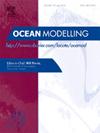Wavelet ocean data assimilation
IF 2.9
3区 地球科学
Q2 METEOROLOGY & ATMOSPHERIC SCIENCES
引用次数: 0
Abstract
Due to necessary assumptions of observational errors with an exigency for appropriate and timely inversion in the assimilation, dense observations are thinned and/or altered before being assimilated into ocean models. Historically, this process did not significantly restrict model skill because most of the observation types had a quite coarse horizontal distribution. However, recent advances in observation resolution demand new assimilation approaches, whereby small-scale features are actively corrected in the model background. A novel method is introduced that applies multiscale data assimilation utilizing the wavelet transform. Unlike other currently employed ocean multiscale techniques, this method is performed in a single analysis step. Utilizing the wavelet transform allows for observational information to be retained at all its original grid points, compared to the averaging and removal in traditional techniques, such as super observations. This comes from the unique space and frequency relation available to the wavelet transform, which instead filters the potentially correlated small-scale observation errors at each model grid point. Several six-month identical twin data assimilation experiments were used to validate the method. Results indicate comparable to substantial improvements over super observations. On average, the sea surface temperature RMSE was 39 % lower for the wavelet method over the six-months compared to super observations. The wavelet method was also able to constrain horizontal scales in assimilation 29 km and above compared to 60 km and above for the super observations.
小波海洋资料同化
由于对观测误差的必要假设以及同化过程中需要适当和及时的反演,密集观测在被同化到海洋模式之前会被稀释和/或改变。从历史上看,这个过程并没有显著地限制模型技能,因为大多数观测类型具有相当粗糙的水平分布。然而,观测分辨率的最新进展需要新的同化方法,即在模式背景中主动校正小尺度特征。提出了一种利用小波变换进行多尺度数据同化的新方法。与目前使用的其他海洋多尺度技术不同,该方法在单个分析步骤中完成。与传统技术(如超级观测)的平均和去除相比,利用小波变换可以将观测信息保留在所有原始网格点上。这是因为小波变换具有独特的空间和频率关系,而小波变换可以过滤每个模型网格点上潜在的相关小尺度观测误差。用几个六个月的同卵双胞胎数据同化实验来验证该方法。结果表明,与超级观测相比,有相当大的改进。与超级观测值相比,小波法测得的6个月平均海面温度RMSE降低了39%。与60 km及以上的超级观测值相比,小波方法还能够约束同化29 km及以上的水平尺度。
本文章由计算机程序翻译,如有差异,请以英文原文为准。
求助全文
约1分钟内获得全文
求助全文
来源期刊

Ocean Modelling
地学-海洋学
CiteScore
5.50
自引率
9.40%
发文量
86
审稿时长
19.6 weeks
期刊介绍:
The main objective of Ocean Modelling is to provide rapid communication between those interested in ocean modelling, whether through direct observation, or through analytical, numerical or laboratory models, and including interactions between physical and biogeochemical or biological phenomena. Because of the intimate links between ocean and atmosphere, involvement of scientists interested in influences of either medium on the other is welcome. The journal has a wide scope and includes ocean-atmosphere interaction in various forms as well as pure ocean results. In addition to primary peer-reviewed papers, the journal provides review papers, preliminary communications, and discussions.
 求助内容:
求助内容: 应助结果提醒方式:
应助结果提醒方式:


